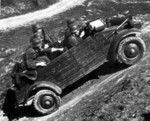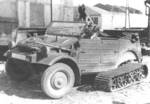Kübelwagen
| Country | Germany |
| Manufacturer | Volkswagen |
| Primary Role | Other |
Contributor: David Stubblebine
Additional Contributions By: Alan Chanter
ww2dbaseKübelwagen
ww2dbaseContributor: David Stubblebine
ww2dbaseResponding to instructions from Adolf Hitler himself, Ferdinand Porsche began developing the Volkswagen (people's car) in the early 1930's. In 1938, before the Volkswagen Type 1 could enter full production, wartime demands caused the design to shift to a military variant (production of the Type 1 did begin after the war in 1945 in what became known as the Beetle - among the most successful car designs in history).
ww2dbaseThe military variant used what was essentially the Type 1's suspension, drive train, and a reinforced chassis but had a body and interior more suitable for military use. The model became known as the Kübelwagen, short for Kübelsitzwagen or "bucket seat car." The prototype was called the Type 62 but the production models were known as the Type 82.
ww2dbaseFull scale production of the Type 82 Kübelwagen started in February 1940, as soon as the VW factories became operational. Except for a larger engine in 1943, no major changes took place until production ended in 1945. Only small modifications were implemented - mostly eliminating unnecessary parts and reinforcing some which had proved unequal to the task.
ww2dbaseSome early prototypes were assembled with four-wheel-drive (Type 86) and different engines, but none offered a significant increase in performance or capability over the existing Type 82 and the designs were only implemented in limited numbers.
ww2dbaseDespite lacking four wheel drive, which was a mainstay of the American Jeeps, the Type 82 proved very competent at maneuvering its way over rough terrain. When the German military took delivery of the first vehicles, they immediately tested them on- and off-road in snow and ice to test them against the European winters; using several four-wheel-drive vehicles as reference points. The two-wheel-drive Kübelwagen surprised even those who had been a part of its development, as it handily out-performed the other vehicles in nearly every test. Most notably - thanks to its smooth, flat underbody - the Type 82 would propel itself much like a motorized sled when its wheels were sinking into sand, snow or mud, allowing it to follow tracked vehicles with remarkable tenacity. The vehicle's light weight, gear-reduction wheel hubs, and self-locking differential more than compensated for the lack of 4X4 capabilities.
ww2dbaseUsed by both the Wehrmacht and the Waffen-SS, the Kübelwagen was for the Germans what the Jeep was for the Allies. The Kübelwagen was 3 cm longer than the Willys MB but the Jeep outweighed the VW by over 300 kg. Capable of 80 km/h (8 km/h faster than the Jeep), the air-cooled engine proved highly dependable in both very hot and very cold climates. It was also less vulnerable to bullets due to the absence of a radiator. As the body was not a load-bearing part of the vehicle's structure, it could easily be field-modified to special purposes. The Kübelwagen also had many factory variants. The Type 155 was a half-track variant that never went into production and the Type 166 was a 4-wheel drive amphibian known as the Schwimmwagen (Floating/Swimming car) that was widely produced with great success.
ww2dbaseIn March 1943, the Kübelwagen received the bigger 1,131 cc engine, originally developed for the Schwimmwagen, that produced more torque and power than the original 985 cc motor. When Volkswagen production ceased at the end of the war, 50,435 Type 82's had been produced and the vehicle had proven itself to be surprisingly useful, reliable, and durable.
ww2dbaseSources:
Wikipedia
Ray Mudway
ww2dbaseSchwimmwagen
ww2dbaseContributor: Alan Chanter
ww2dbaseThe amphibious Volkswagen Type 128 and 166 Schwimmwagen ("Swimming car") was introduced in 1942 to meet a need for a light reconnaissance vehicle capable of crossing the many streams and rivers that confronted the German troops in Russia. Although nominally a Kübelwagen car, there were a number of mechanical differences from the standard car. The body was constructed of metal pressing welded together to form a watertight hull, and the transmission was altered to give an auxiliary low gear which came into operation whenever four-wheel drive was selected. To propel the car in water there was a propeller unit which hinged up, over the rear of the car, when not in use. When lowered into operating position it was automatically engaged with an extension from the engine crankshaft and the drive went via a chain and sprocket gearing to the propeller. In the water, Schwimmwagen had a speed of 10 kilometers per hour.
ww2dbaseThe Schwimmagen (like the Kübelwagen was derived from the VW Beetle automobile) was a successful and popular vehicle, and a relatively common sight on the battlefield throughout the Second World War. But in 1944 when the tactical situation changed, there was less need for it and production was dropped. Some 15,584 Schwimmagen were built between 1942 and 1944.
ww2dbaseSources:
Ian V. Hogg and John Weeks: The Illustrated Encyclopedia of Military Vehicles (Hamlyn Publishing, 1980)
Simon Forty: German Infantrymn - The German Soldier 1939-45 (Haynes Publishing, 2018)
Last Major Revision: Jan 2011
SPECIFICATIONS
Type 82 Kübelwagen
| Machinery | One air-cooled flat-4 985cc or 1,131cc engine rated at 23hp or 25hp |
| Suspension | Wheels, 2x4 |
| Crew | 1 |
| Length | 3.74 m |
| Width | 1.60 m |
| Height | 1.65 m |
| Weight | 0.7 t |
| Speed | 80 km/h |
Type 166 Schwimmwagen
| Machinery | One Volkswagen air-cooled 1,130cc 4-cyl horizontally-opposed Boxer engine rated at 25hp |
| Suspension | Torsion Bar |
| Armament | 1x7.92mm MG34 machine gun |
| Crew | 1 |
| Length | 4.83 m |
| Width | 1.48 m |
| Height | 1.62 m |
| Weight | 0.9 t |
| Speed | 80 km/h |
| Range | 250 km |
Photographs
 |  |  |  |
Please consider supporting us on Patreon. Even $1 per month will go a long way! Thank you. Please help us spread the word: Stay updated with WW2DB: |
Visitor Submitted Comments
31 Mar 2018 05:00:16 AM
interested in a Kubelwagen body number 35821
Regards George
30 Sep 2018 08:05:39 PM
George, what do you mean you are interested in body number 35821? Do you have this body or are you looking for it?
22 Jan 2019 04:59:47 PM
In a Smithsonian museum pamphlet, I once saw the Official Wehrmacht name was "Light unarmoured vehicle for carrying four armed troops". I have been unable to find that name again.
Can anyone help?
20 Oct 2021 06:33:55 PM
Where can you buy any parts today,Repo or OEM for a restoration
All visitor submitted comments are opinions of those making the submissions and do not reflect views of WW2DB.
- » US Government Plans to Purge WW2 Information (17 Mar 2025)
- » WW2DB's 20th Anniversary (29 Dec 2024)
- » Wreck of USS Edsall Found (14 Nov 2024)
- » See all news
- » 1,167 biographies
- » 337 events
- » 44,601 timeline entries
- » 1,243 ships
- » 350 aircraft models
- » 207 vehicle models
- » 376 weapon models
- » 123 historical documents
- » 261 facilities
- » 470 book reviews
- » 28,520 photos
- » 367 maps
Captain Henry P. Jim Crowe, Guadalcanal, 13 Jan 1943
Please consider supporting us on Patreon. Even $1 a month will go a long way. Thank you!
Or, please support us by purchasing some WW2DB merchandise at TeeSpring, Thank you!
12 Nov 2014 05:00:42 AM
great site